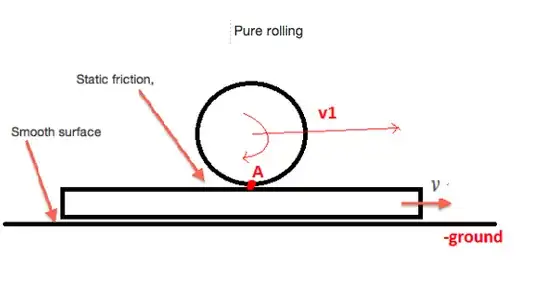
Here $v1$ is relative to the block on which sphere is pure rolling but static friction isn't $0$ as of now .
In the following diagram, is work done by static friction $0$ ?, since the point of application is also moving with speed $v$ w.r.t. ground here and is only stationary w.r.t. the block on which sphere is rolling w.r.t. ground here .
If it isn't $0$ , where is static friction increasing net Kinetic Energy of the rolling sphere?
The mass of the block which is on smooth surface $\rightarrow \infty$.
Additional comment : Because when we consider rolling w.r.t. ground of a new sphere, the net kinetic energy doesn't change . Rolling KE changes to translation KE or vice-vera depending upon situation . And now static friction should also do this in this case also , however , the deinition of work is also $\vec {F}\cdot \vec {dx}$ for point of application and and now point of application is always moving with $v$ w.r.t. ground, so according to this definition work is not $0$ . So is Kinetic Energy increasing somewhere w.r.t. ground? And if it isn't increasing there's something wrong with the way I am defining work ?
EDIT: You can also consider evaluating work for an incline plane wedge falling in free space which has a sphere rolling on it and gravity and air resistive forces are acting on both the rolling sphere and the inclined plane .
The inclined plane has attained terminal velocity and the rolling sphere is still accelerating along the incline only in net . and the inclined plane wedge's terminal velocity's direction is ** along the same direction with the horizontal as is the direction of the incline plane's slopy surface. ** And also mass of the incline plane wedge $\rightarrow \infty$.